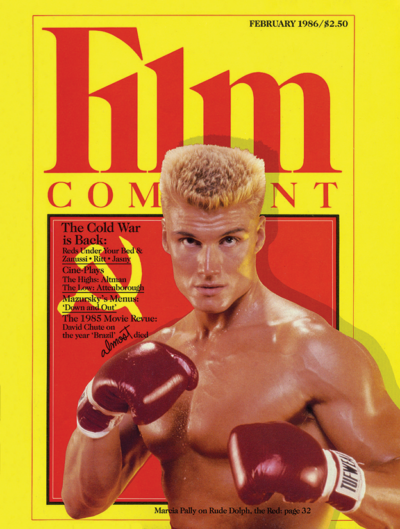WHAT’S IN COLOR AND RED ALL OVER
As Gorbachev and the Gipper make strange animal sounds (for war or mating?) on the world stage, Hollywood churns out hits—Rambo, Rocky IV, White Nights—that suggest it has been commissioned to make training films for World War III, or anyway Cold War II. Marcia Pally analyzes the new esprit de corpse
Cold War I was also the heyday of McCarthyism. In a conversation with Pat McGilligan, blacklist victim Martin Ritt recalls the bad old days and mulls the bad new ones
From the other side of the shredded Iron Curtain, three prominent voices are heard: those of Polish director Krzysztof Zanussi and actress Maya Komorowska talking with Marcia Pally, and Czech New Wave godfather Vojtech Jasny interviewed by Marlaine Glicksman
THE 1985 MOVIE REVUE
Graybeards can remember a time—back in the 1960s, it was, my children—when each movie year actually seemed better than the last, when film was our brand-new, very own art form. Now? Naaaah. Now critics and picturegoers both seem to be suffering from post-Film Generation depression, and badmouthing the cinema has become a year-end tradition, like holiday death statistics. So David Chute keens over the corpse of film, and film criticism
In 1985 and All That, Stephen Harvey remembers the seediest, not to mention the stupidest
And Anne Thompson tracks the Motion Picture Academy’s attempts to find five potential winners in a pack of losers. Our prescription: Take two classic videocassettes, climb into bed, and call us in the morning
THEATER TO FILM
Stage is fake; screen is real. And always the twain will meet. Armond White has provocative thoughts about the recent play-to-screen works, as part of a comprehensive essay on the two arts
BEVERLY HILLS BRUNCH
Paul Mazursky interviewed by Mitch Tuchman
Paul Mazursky believes “We are what we eat,” and has the films (his new Down and Out in Beverly Hills, e.g.) to prove it
JOURNALS
Ten years ago it was the film nobody wanted; now it is a cult phenom that has grossed $60 million. Stephen Schaefer reports on The Rocky Horror Picture Show. No horrors at Venice this year, just lots of birds, in and outside the movies. Harlan Kennedy has the story
TOUGH GUY
In 1929 John Bright breezed into Hollywood. He stayed to make movies (like The Public Enemy) and trouble, from the Screen Writers Guild to the Blacklist. He relates it all, tangily, to our Lee Server
TELEVISION: TAKE TWO
Jeff Greenfield on Mad Ave’s new US-first politique. Terrence Rafferty on the soap operatics of Another World
VIDEO: NVF
It devours film; it turns hijackings into serials, and politicians into TV stars. God help us, TV is the world, and the fifth National Video Festival has a good part of the world on display. Meredith Brody got most of it
ORBITS: ORSON WELLES
From the beginning, his films were a series of little deaths, big elegies. When he died, though, no one was there to film his Rosebud. Dave Kehr pays eloquent tribute to a magnificent failure
BACK PAGE: Quiz #17




